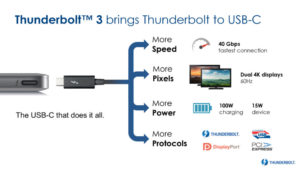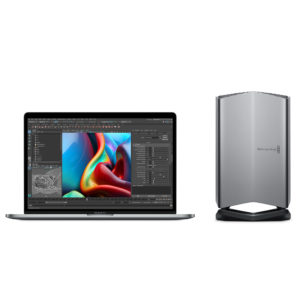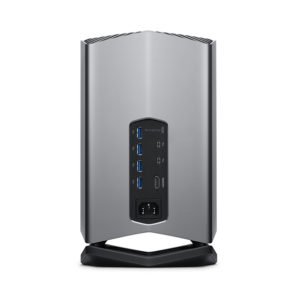- Published on
ThunderBolt 3, and eGPUs A New Form Factor in Computing
- Authors
- Name
- Sam Mark
- @Twitter/smmk

Thunderbolt 3 is a relatively new standard by Intel in late 2015. It uses the USB-C standard for the physical connections. Which makes it a little confusing, but it makes the physical cables needed cheap and gives the devices ability to be compatible with the USB 3.1 standards. Basically Thunderbolt 3 inherits all the ability and standards of USB 3.1 including the 10 Gbps that USB 3.1 can transfer. The place where Thunderbolt 3 stands out is that is is capable of 40 Gbps speeds and on Intel platforms links directly with the PCI Express bus. This allows its one standout feature the ability to link laptops to external GPUs using a small USB-C cable. This opens up a whole new market. Now Consumers can have a ultraportable laptop that they can hookup to and eGPu to game while they are at home.
Being that Thunderbolt 3 uses USB-C i think it is important to let consumers, end-users know that not all USB-C ports will support thunderbolt 3 speeds and capabilities. And not all devices will have thunderbolt 3 compatibility if the have USB-C. This is due to the fact that Thunderbolt 3 is an stander developed by intel in collaboration with Apple. While USB is a standard developed by a joint non-profit group made up of leading tech companies. The USB-C is fairly cheap to license sometimes it can even be free if you order a certain amount from manufacturer. Where as thunderbolt 3 is license from intel. Intel has claimed it will make Thunderbolt 3 free to license, but as of july of 2018 has not done so.
External GPUs or eGPUs have been on the market for a while. Before thunderbolt 3 one of the solutions was a dock for the GPU that used a cable to link to and internal or external PCI-E mini like those used for wireless LAN cards these were not ideal and lack driver support from many laptop manufacturers. But since thunderbolt 3 many major manufacturers have been making external enclosures to support the newest GPUs and supply the immense power that they require.
One of the major issues that eGPU users have to contend is the overhead that Thunderbolt 3 needs to compress or process the signal from the PCI-E 16x lans into the Thunderbolt 3 signal and then over to the GPU and to the monitor. This clocks in at around ~20% performance drop if you are using a monitor connected to the eGPU. If you are using the eGPU and the laptop’s screen the Performance hit can be around 20%-30%.
Another major issue is that the GPUs need extra hardware to be utilized as a eGPU they often need in excess of 300 watts and are called upon to charge the laptop while docked. They eGPUs also need thunderbolt 3 chipset with a link to an PCI-E 16x connector form the GPU itself. Also many offer extra usb connections for external devices that the laptop can connect to. This raises the costs significantly and causes segmentation in the offering for these enclosures. Thunderbolt 3 is a game changer when it comes to Form factors but price and performance are considerations when deciding to go this route.


